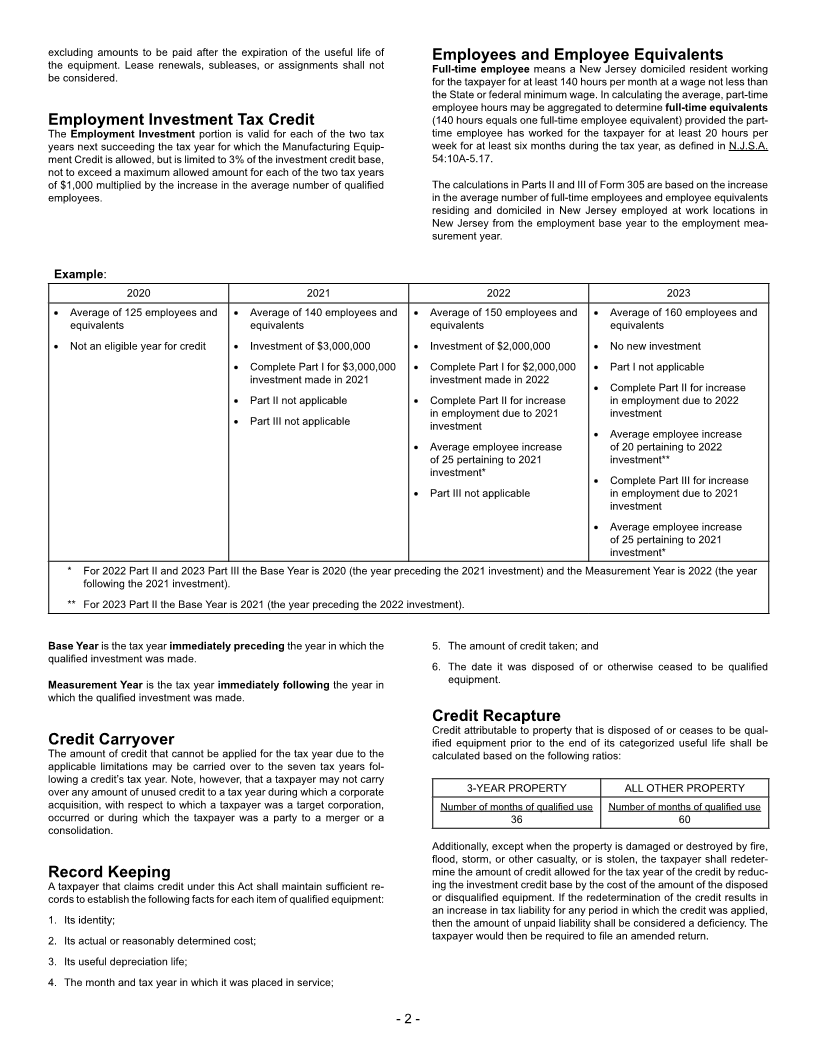
Enlarge image
New Jersey Corporation Business Tax
FORM 305
Manufacturing Equipment and Employment
2023
Investment Tax Credit
Name as Shown on Return Federal ID Number Unitary ID Number, if applicable
NU
Read the instructions before completing this form.
Combined Return Filers
The taxpayer is included as a taxable member on a New Jersey combined return. See instructions.
Fill in oval if member is not sharing its credit with other members of the group.
Part I Credit Calculation for Investment in Qualified Equipment in
New Jersey in the CURRENT YEAR
1. Enter the cost of qualified equipment placed in service in N.J. during the current year ............ 1.
2. Enter 2% (.02) or 4% (.04) of line 1, whichever applies ............................................................ 2.
3. Enter the lesser of line 2 or $1,000,000..................................................................................... 3.
If you have prior years’ manufacturing equipment investments combined with increased
employment, complete Parts II and/or III. Otherwise, go to Part IV.
Part II Employment Investment Tax Credit Calculation for Investment in Qualified
Equipment in New Jersey Made ONE YEAR PRIOR to the Current Tax Year
4. Average number of N.J. employees in the current year (Measurement Year) ........................... 4.
5. Average number of N.J. employees in the tax year prior to the year that qualified equipment
was placed in service in N.J. (Base Year) ................................................................................. 5.
6. Subtract line 5 from line 4 (if zero or less, enter zero on line 10) .............................................. 6.
7. Multiply line 6 by $1,000 ............................................................................................................ 7.
8. Enter the cost of qualified equipment placed in service in N.J. one year prior to the current
tax year (from line 1, Form 305 of prior year) ............................................................................ 8.
9. Enter 3% of line 8 ...................................................................................................................... 9.
10. Enter the lesser of line 7 or line 9 .............................................................................................. 10.
Part III Employment Investment Tax Credit Calculation for Investment in Qualified
Equipment in New Jersey Made TWO YEARS PRIOR to the Current Tax Year
11. Average number of N.J. employees in the prior tax year (Measurement Year) ......................... 11.
12. Average number of N.J. employees in the tax year prior to the year that qualified equipment
was placed in service in N.J. (Base Year) ................................................................................. 12.
13. Subtract line 12 from line 11 (if zero or less, enter zero on line 17) .......................................... 13.
14. Multiply line 13 by $1,000 .......................................................................................................... 14.
15. Enter the cost of qualified equipment placed in service in N.J. two years prior to the current
tax year (from line 1, Form 305, 2 years prior) 15.
16. Enter 3% of line 15 .................................................................................................................... 16.
17. Enter the lesser of line 14 or line 16 .......................................................................................... 17.
Part IV Calculation of the Available Credit
18. Enter the total of the amounts on lines 3, 10, and 17 ................................................................ 18.
19. Manufacturing Equipment and Employment Investment Tax Credit carried over from prior
year............................................................................................................................................ 19.
20. Total credit available. Add line 18 and line 19............................................................................ 20.




